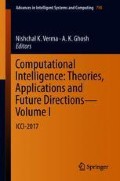Abstract
This paper presents the application of fuzzy logic theory for aerodynamic modeling of the fixed wing aircraft. For the demonstration purpose, yawing moment control and stability derivatives of ATTAS aircraft are extracted from the recorded flight data of nonlinear flight profile. Fuzzy-logic-based Takagi-Sugeno (TS) model is used to represent the nonlinear dynamics of the aircraft, which can approximate it into several local linear models. The method shows its benefit when it becomes very difficult to identify the equilibrium points (trim points) due to cross-coupling and nonlinear complexities associated with modern aircraft. The Gustafson and Kessel (G-K) based clustering algorithm is used for fuzzy partitioning of the input spaces. The Gaussian type membership functions are used and its parameters are generated from the training dataset. The fuzzy rules are extracted based on weighted least square algorithms and each rule corresponds to local linear model for mimicking aerodynamic (control and stability) derivatives. Fivefold cross-validation method is used to assess the adequacy of the generated fuzzy model. The parameter tracking trends and mean square error for training and testing data sets show commendable modeling capability of TS fuzzy model for extraction of aerodynamic derivatives.
Access this chapter
Tax calculation will be finalised at checkout
Purchases are for personal use only
References
Klein, V., Morelli, E.: Aircraft System Identification: Theory and Practice. AIAA, Reston, VA (2006)
Tischler, M., Remple, R.: Aircraft and Rotorcraft System Identification. AIAA, Reston, VA (2006)
Jategoankar, R., Fishenberg, D., Gruenhagen, W.: Aerodynamic modeling and system identification from flight data—recent applications at DLR. J. Aircr. 41(4), 681–691 (2004). https://doi.org/10.2514/1.3165
Jategaonkar, R.V.: Flight Vehicle System Identification A Time Domain Methodology. American Institute of Aeronautics and Astronautics Inc., Reston, Virginia (2006)
Singh, V., Dev, R., Dhar, N.K., Agrawal, P., Verma, N.K.: Adaptive type-2 fuzzy approach for filtering salt and pepper noise in grayscale images. IEEE Trans. Fuzzy Syst. (2018)
Nelles, O.: Nonlinear System Identification from Classical Approaches to Neural Networks and Fuzzy Models. Springer, Berlin, Heidelberg (2001)
Ghosh, A.K., Raisinghani, S.C., Kalra, P.K.: Two new techniques for aircraft parameter estimation using neural networks. Aeronaut. J. 102(1011), 25–29 (1998)
Ghosh, A.K., Raisinghani, S.C., Khubchandani, S.: Estimation of aircraft lateral-directional parameters using neural networks. J. Aircr. 35(6), 876–881 (1998). https://doi.org/10.2514/2.2407
Ghosh, A.K., Singh, S.: Parameter estimation from flight data using maximum likelihood method and neural network. In: Atmospheric Flight Mechanics Conference and Exhibit-06, Colorado, AIAA Paper No. 2006-6284 (2006)
Ghosh, A.K., Peyada, N.K.: Aircraft parameter estimation using neural network based algorithm. In: AIAA Atmospheric Flight Mechanics Conference, 10–13 Aug 2009, Chicago, Illinois
Sevakula, R.K., Verma, N.K.: Compounding general purpose membership functions for fuzzy support vector machine under noisy environment. IEEE Trans. Fuzzy Syst. 25(6), 1446–1459 (2017)
Rajurkar, S., Singh, V., Verma, N.K., Cui, Y.: Deep stacked auto-encoder with deep fuzzy network for transcriptome based tumor type classification. BMC Bioinformatics, vol. 18 (2017)
Verma, N.K., Hanmandlu, M.: Additive and nonadditive fuzzy hidden Markov models. IEEE Trans. Fuzzy Syst. 18(1), 40–56 (2010)
Verma, N.K., Hanmandlu, M.: From a gaussian mixture model to nonadditive fuzzy systems. IEEE Trans. Fuzzy Syst. 15(5), 809–827 (2007)
Ross, T.J.: Fuzzy logic with Engineering Applications, 3rd edn. Wiley, West Sussex, UK (2010)
Takagi, T., Sugeno, M.: Fuzzy identification of systems and its application to modelling and control. IEEE Trans. Syst Man Cybern. SMC-15, 116–132 (1985)
Singh, D.J., Agrawal, P., Verma, N.K., Ghosh, A.K., Malagaudanavar, A.: Interval type-2 TS fuzzy model for angle of attack sensor of the aircraft. J. Intell. Fuzzy Syst., 1–11 (2017)
Gustafson, D.E., Kessel, W.C.: Fuzzy clustering with fuzzy covariance matrix. In: Proceedings of the IEEE CDC, San Diego, pp. 761–766 (1979)
Abonyi, J., Balazs, F.: Cluster Analysis for Data Mining and System Identification. Birkhauser Verlag AG, Basel, Boston, Berlin (2007)
Mendel, J.M.: Uncertain Rule Based Fuzzy Logic Systems. Prentice Hall PTR Inc., Upper Saddle River, New Jersey (2001)
Verma, N.K., Roy, A.: Self-optimal clustering technique using optimized threshold function. IEEE Syst. J. 8(4), 1213–1226 (2014)
Verma, N.K., Hanmandlu, M., Ahmad, N.: Cluster-weighted modeling for an Interactive fuzzy system. In: Proceeding of CERA 2005, An International Conference, vol. 2. IIT Roorkee, India, 29 Sept–01 Oct 2005
Verma, N.K., Hanmandlu, M.: Interactive fuzzy system using CWM. In: Proceedings of IEEE Indicon 2005 Conference, Chennai, India, pp. 375–378, 11–13 Dec 2005
Verma, N.K., Haumandlu, M.: Data driven model using Adaptive Fuzzy System. Int. J. Autom. Control 2(4), 447–458 (2008)
Abonyi, J., Babuska, R.: Local and global identification and interpretation of parameters in Takagi-Sugeno fuzzy models. In: Proceedings of IEEE International Conference on Fuzzy Systems, San Antonio, USA, May 2000
Author information
Authors and Affiliations
Corresponding author
Editor information
Editors and Affiliations
Rights and permissions
Copyright information
© 2019 Springer Nature Singapore Pte Ltd.
About this paper
Cite this paper
Singh, D.J., Verma, N.K., Ghosh, A.K., Sanwale, J., Malagaudanavar, A. (2019). Aerodynamic Parameter Modeling Using TS Fuzzy Systems from Flight Data. In: Verma, N., Ghosh, A. (eds) Computational Intelligence: Theories, Applications and Future Directions - Volume I. Advances in Intelligent Systems and Computing, vol 798. Springer, Singapore. https://doi.org/10.1007/978-981-13-1132-1_33
Download citation
DOI: https://doi.org/10.1007/978-981-13-1132-1_33
Published:
Publisher Name: Springer, Singapore
Print ISBN: 978-981-13-1131-4
Online ISBN: 978-981-13-1132-1
eBook Packages: Intelligent Technologies and RoboticsIntelligent Technologies and Robotics (R0)

